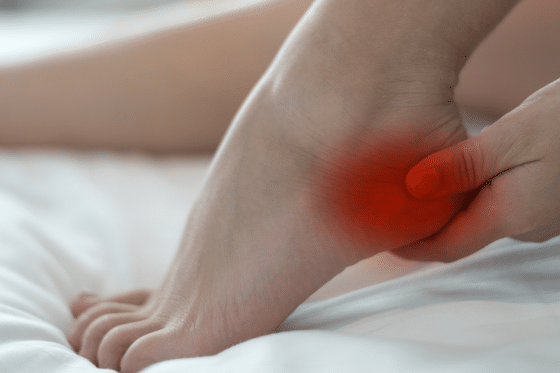7 Things That Can Trigger Heel Pain
Heel pain is one of the most common issues we see in clinic, and if you’re reading this, chances are you’ve experienced it too. Whether it’s a dull ache first thing in the morning or sharp pain after walking for a while, heel pain can have a serious impact on your day-to-day life.
But here’s the good news: most heel pain isn’t something you have to live with. The first step is understanding what’s causing it—and once you do, the path to recovery becomes much clearer.
In this blog, we’ll walk you through 7 common triggers for heel pain, how to spot them, and most importantly, what you can do to find relief.
1. Plantar Fasciitis – The Most Common Culprit
If you’ve ever felt a stabbing pain under your heel as you get out of bed in the morning, this one might sound familiar. Plantar fasciitis happens when the thick band of tissue (the plantar fascia) that runs along the bottom of your foot becomes irritated.
What triggers it?
- Overuse
- Poor footwear
- Tight calves
- Prolonged standing
The pain is usually worst in the morning or after rest and can improve slightly with movement, only to return later. It’s a stubborn one—but it can be treated. At Foot Focus, we use a mix of hands-on therapy, custom orthotics, and exercises tailored to your specific issue.
2. Flat Feet or Fallen Arches
Your foot’s arch is designed to act like a shock absorber. But when that arch starts to collapse—whether from genetics, age, or injury—it places more pressure on the heel.
This can lead to chronic heel pain and, if left untreated, problems in the ankles, knees, hips, and even your back.
The fix? We start by assessing your walking pattern and foot alignment. In many cases, a properly fitted orthotic can provide the support your arch needs and take the strain off your heel.
3. Tight Calf Muscles
You wouldn’t believe how many people are walking around with tight calves and don’t even realise it. The calf connects to the heel through the Achilles tendon, so when the calf is tight, it pulls on the heel and places extra tension on the plantar fascia too.
What to do? A simple stretching routine—done properly and consistently—can make a world of difference. One of our favourite sayings in clinic is:
“Motion is lotion.” A bit of the right movement can work wonders for your feet.
4. Wearing the Wrong Footwear
This is a big one, and it’s an easy trap to fall into. Flip-flops, worn-out runners, or fashionable but unsupportive shoes can all lead to heel pain. Even walking barefoot on hard surfaces can cause problems if you’re prone to foot issues.
Your footwear should:
- Provide arch support
- Have cushioning under the heel
- Be appropriate for the activity you’re doing
And no, you don’t need to break the bank. But you do need something that supports your feet properly. If you’re unsure what to go for, we’re always happy to give some honest advice.
5. Overuse or Sudden Increase in Activity
Whether you’ve just taken up couch-to-5K or decided to go all in on your New Year fitness goals, ramping up activity too quickly can overload the heel.
The foot absorbs massive force with every step—up to 3 times your bodyweight when running. Without a proper build-up, the plantar fascia and Achilles tendon can become irritated.
We always tell patients: It’s not about stopping—it’s about pacing. Knowing your limits, listening to your body, and working with a plan tailored to your level can prevent pain and long-term problems.
6. Being on Your Feet All Day
If you work in retail, healthcare, construction, or any job that keeps you on your feet for hours, you’ll know the toll it can take.
Even with decent shoes, standing for prolonged periods causes fatigue and strain on your heel. The muscles and tendons become overloaded, and over time, inflammation can creep in.
Prevention tip: switch shoes mid-day if you can, take sitting breaks, stretch regularly, and use a foot roller or ice bottle when you get home.
7. Previous Injury or Poor Gait
Old sprains, injuries, or even just poor walking habits can throw off your body’s natural alignment. That compensation—whether it’s favouring one side or overloading one foot—often lands in the heel.
At Foot Focus, we don’t just treat the symptoms. We look at how you walk, move, and stand. Once we spot what’s contributing to your heel pain, we’ll put a plan in place to correct the root cause, not just patch it up.
What Should You Do If You Have Heel Pain?
Start by paying attention.
- When is the pain worst?
- Is it sharp or dull?
- Do certain shoes or activities make it worse?
Next, take action:
- Try calf stretches and foot rolling
- Avoid going barefoot on hard floors
- Rest, but don’t stay completely inactive
- Consider switching to more supportive footwear
But most importantly—don’t leave it untreated. The longer heel pain goes on, the more complex it can become. What starts as a minor annoyance can quickly turn into something that affects every step you take.
Final Thoughts from Mark & Ste
Heel pain doesn’t just affect your feet—it affects your whole day. But the great news is, it’s highly treatable once you understand what’s causing it.
If you’re fed up of limping around or planning your outings around how far you can walk, let us help. We’ve seen it all before—and we’ve helped thousands of people just like you get back on their feet, doing what they love pain-free.
📞 Give us a ring on (01) 556 3662
📍 Find us in Mount Merrion & Finglas
And remember—motion is lotion. Let’s get you moving again.

